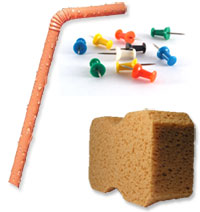Comparing Insect Mouth Types
Did you know that some scientists estimate there are between 15 and 30 million different species of insects in the world? That amount makes up almost 75% of the total animal population! In other words if you could group every animal on Earth together and pick out 100 of them with your eyes closed, about 75 would be insects! Pretty amazing, isn't it?
Even more interesting is that of all those insects, every family has different characteristics and different lifestyles. There are different kinds of wings, antennae, legs, eyes, you name it! In this activity, you will learn about the different types of mouths that insects have and will even be able to experience eating like an insect!
What You Will Learn
By the time this activity is over, you will know the four general mouth types found in insects and how they are used to get nutrients.
What You Will Need
- Plastic ziploc bags
- Clean pieces of sponge
- Water
- Straws
- Push-pins
- Styrofoam dish/bowl
- Chewing gum
What To Do
- First, gather together all of your materials.
- Now place a small amount of water into your bag and seal it up tight. You are about to eat like a true bug!
- Next, use the push-pin to punch a little hole in the bottom corner of the bag. Don't drip! Try to drink the water through this hole. Hard, isn't it? This is called a piercing-sucking mouth type and insects like stink bugs use this method to get their nutrients.
- Have you ever wondered how a fly eats when it lands on your sandwich? Well, flies have a mouth type called sponging. To eat like a fly, pour a little water into your dish or bowl and wet your sponge. Try to drink as much water from the sponge as you can. This is what flies do!
- To eat like a butterfly, you'll need your straw. Butterflies and moths have long tube-like mouth parts that let them reach way into a flower to drink the nectar . . . kind of like a straw! This is called a siphoning mouth type. So now it's your turn. Use your straw to eat like a butterfly and take a big sip!
- Finally, it's time for the chewing gum! Probably the most basic mouth type is chewing. It is used by many insects including beetles. So pop a piece of gum in your mouth and see how it feels to eat like a beetle!
Think About It
Great job! So now you've learned the four basic mouth types found in insects: Piercing-sucking, Sponging, Siphoning, and Chewing. What did you think was the easiest way to get nutrients? The hardest? What are some other ways that insects might get their food?
Going Further
As a person, why do you think it might be helpful or harmful for insects to have different mouth types? What if you were a plant? Why might different mouth types be helpful or harmful now?

